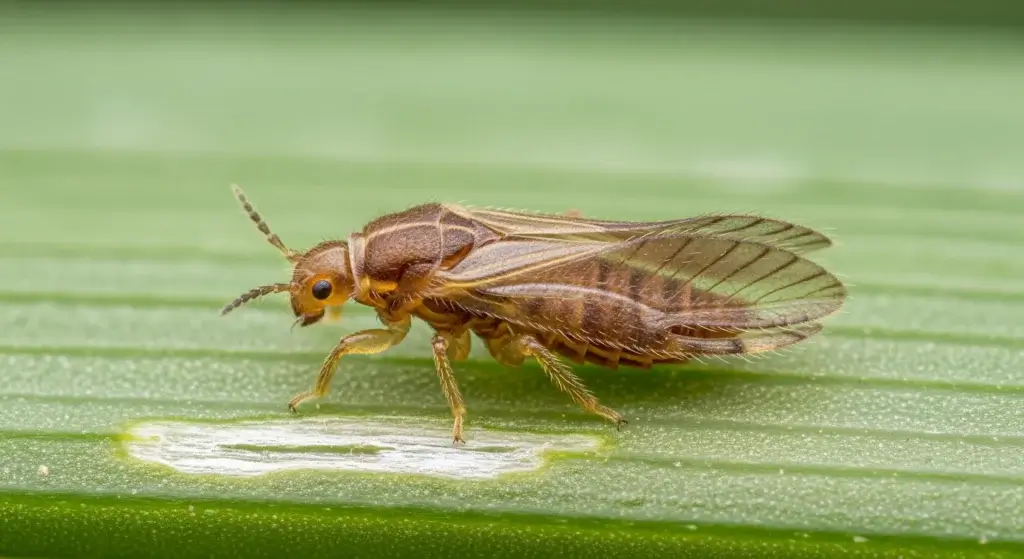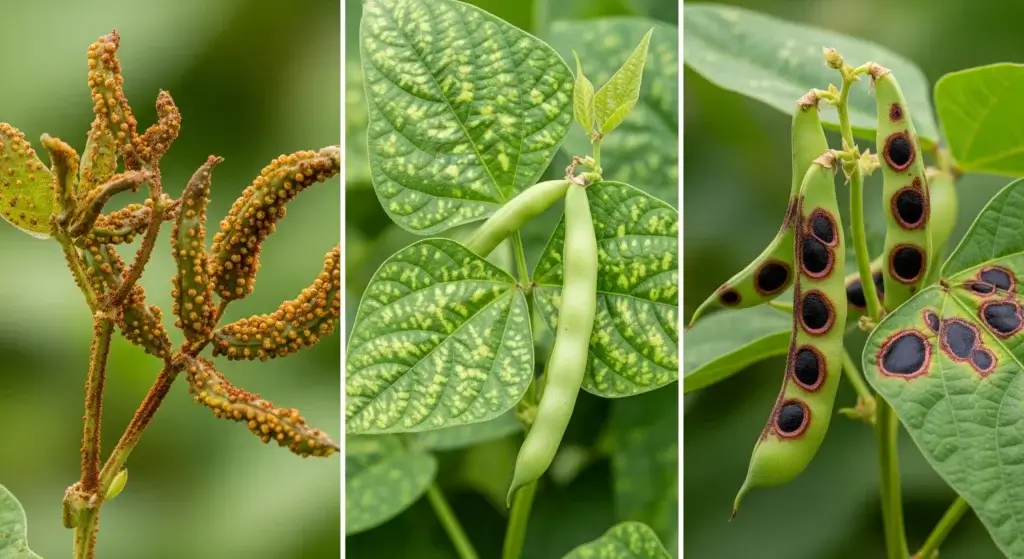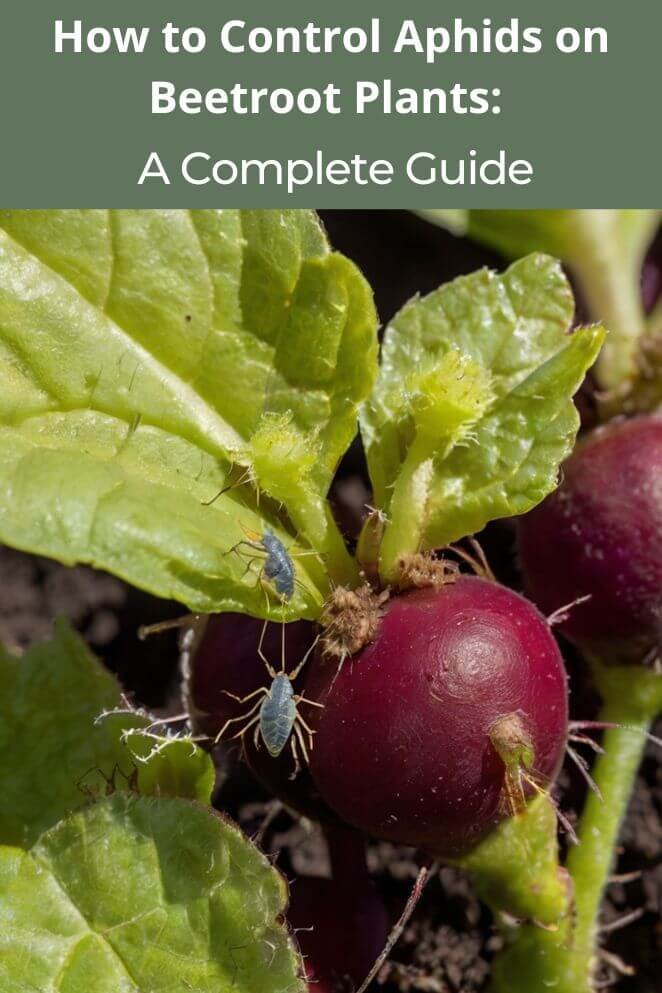
Aphids are like the freeloaders of the garden—tiny bugs that crash your beetroot party and multiply faster than Gremlins in water.
Left alone, they’ll suck the life out of your plants and wreck your harvest.
If you’re growing beetroot (whether it’s your first try or you’ve got dirt under your nails year-round), you need to know how to spot these pests early and kick them out fast.
This quick guide covers how to find, stop, and squash aphid infestations so your beets stay strong and your garden stays drama-free.
Identifying Aphid Damage on Beetroot Plants
Catching aphids early is like spotting a plot twist before the villain reveals themselves.
Here’s how to tell if your beets are under aphid attack:
Visual symptoms
Check the undersides of leaves and fresh new growth—aphids love to hang out where it’s cozy.
They’re tiny, squishy, and come in all kinds of colors: green, black, gray, even red.
Think of them as the garden version of uninvited houseguests who eat your food and leave a mess.
Plant damage indicators
Leaf Distortion
Are your beet leaves looking all curled, cupped, or twisted like they’ve had a rough day?
That’s aphids injecting their plant-sabotage juice (aka toxins) while feeding. It messes with how the leaves grow. Not cute.
Yellowing and stunted growth
When aphids suck out plant juices, they steal the nutrients your beets need to grow.
You’ll see older leaves turning yellow, and the whole plant might just look… tired. Less energy = sad beets.
Sticky honeydew
Aphids poop sugar. Yeah, it’s called honeydew, and it leaves a shiny, sticky coating on leaves.
Ants love it (they even farm aphids for it), and sooty mold shows up next like it’s a house party. None of this helps your plants.
Wilting and reduced vigor
If things get bad, your beet plants might just droop like they’ve given up.
That’s a sign the infestation’s out of hand, and your harvest could end up small or misshapen. Nobody wants sad beets.
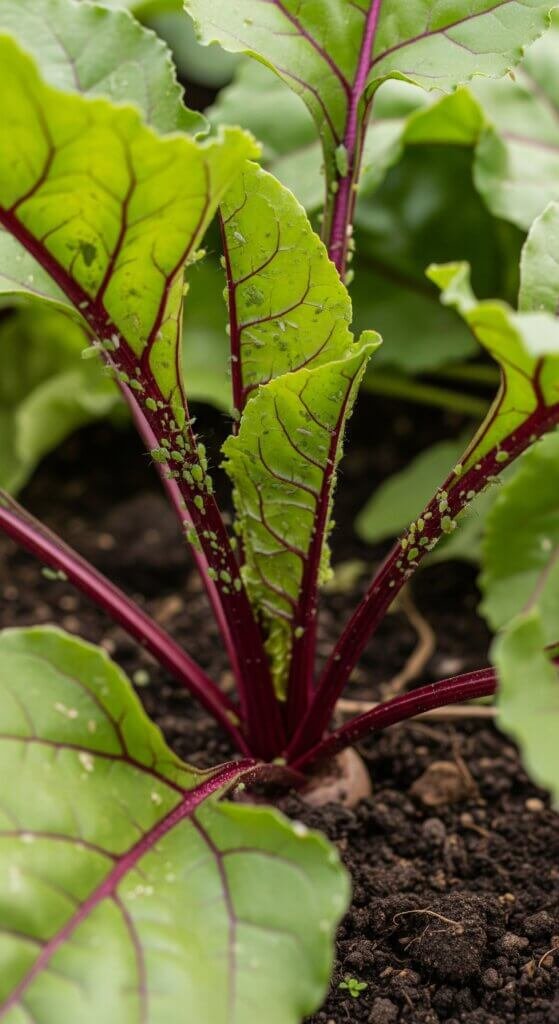
Prevention: Your First Line of Defense
Best way to deal with aphids? Don’t let them move in to begin with.
Think of this like setting up garden-level home security—minus the lasers and alarms.
Here’s how to make your beet patch totally uninviting for those soft-bodied suckers:
Companion Planting for Natural Deterrence
Aphids hate certain smells. Use that against them.
- Herbs like sage, mint, and rosemary = Mother Nature’s bug repellent. Surround your beets with these and you’ll basically build a smelly wall aphids won’t want to climb.
- Onions, garlic, and chives = Aphids can’t stand the stink. Great news for your garden. Not so great for vampires or bugs.
- Nasturtiums & mustard plants = Aphid bait. They’re the garden equivalent of setting out donuts for cops—aphids rush in, leaving your beets alone.
Encouraging beneficial insects
Aphids have enemies. You want those enemies on your side. Plant stuff like:
- Yarrow
- Sweet alyssum
- Cosmos
- Buckwheat
- Queen Anne’s lace
These flowers are like five-star hotels for ladybugs, lacewings, and tiny parasitic wasps—basically, the Avengers of natural pest control.
They swoop in, chow down on aphids, and keep your beets safe without you lifting a finger.
Cultural practices for prevention
Good garden habits = fewer pest dramas.
- Check your plants weekly. Look under leaves and around new growth. If you see bugs, act fast. Don’t wait for it to turn into a full-blown garden soap opera.
- Give your beets some breathing room. Don’t crowd them. Aphids love tight, humid spaces. Open layout = fewer places for them to hide.
- Skip the all-you-can-eat fertilizer buffet. Overfeeding your plants with nitrogen makes their leaves soft and juicy—exactly what aphids love.
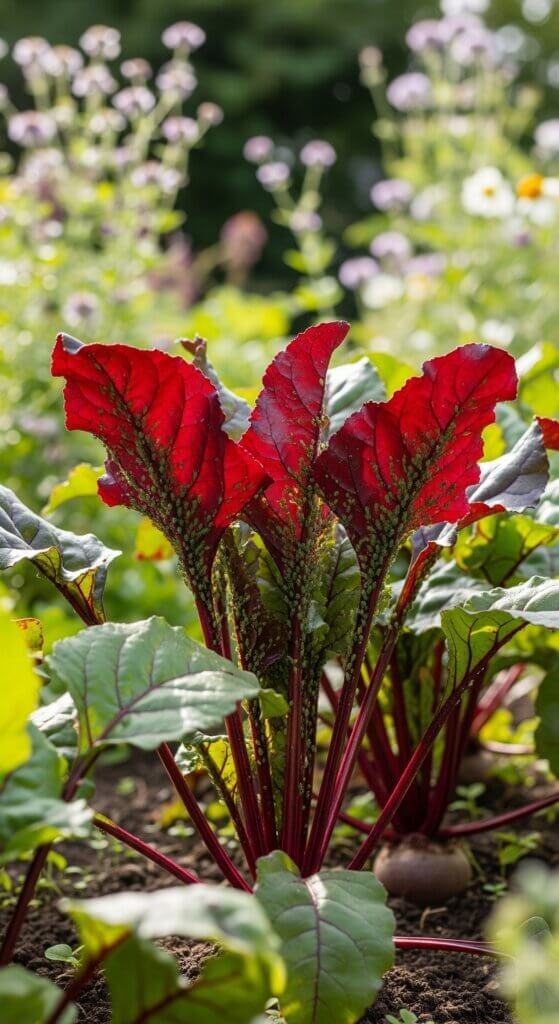
Organic Control Methods
So the aphids showed up anyway. Cool cool cool.
Don’t panic—you’ve got a toolbox full of organic, beet-friendly ways to send them packing.
Think of it like pest control, but make it eco-chic.
Water spray treatment
When in doubt, hit ‘em with the hose.
- What to do: Blast the undersides of leaves with a strong spray of water. Aphids can’t hold on like Spider-Man—they’ll drop.
- When to spray: Do it in the morning, so plants dry off by night (wet leaves overnight = fungal party, and no one wants that).
- How often: Every 2–3 days until you stop seeing bugs.
Soap solution spray
Aphids hate soapy water. It messes with their waxy little bodies.
- Recipe: 1–2 teaspoons of plain liquid dish soap (no degreasers, no antibacterial) in 1 quart of water.
- Spray the whole plant, top and bottom of leaves. Give ‘em the full spa treatment.
- When to apply: Early morning or evening—midday sun + soap = crispy plants.
- Repeat every 2–3 days for a couple of weeks or until those freeloaders are gone.
Neem oil treatment
Neem is like the Swiss Army knife of garden care. It confuses aphids and stops them from reproducing.
Bonus: it also helps with fungi and other pests.
- Mix: Usually 1–2 tablespoons of neem oil per gallon of water + a few drops of soap to help it mix.
- Spray weekly (every 7–14 days), but not when flowers are blooming—save the bees, please.
- Heads up: Neem smells a little… funky. But it works. And it’s safe.
Essential oil spray
This is basically aromatherapy—but for murdering aphids.
- Mix: 4–5 drops each of peppermint, clove, rosemary, and thyme oil in 1 cup of water. Shake it like a Polaroid picture.
- Spray thoroughly, including the undersides of leaves. Aphids and larvae, gone.
- Reapply every 3–4 days until peace is restored in your beet kingdom.
Biological Control Options
Skip the sprays—biological control is your garden’s secret weapon.
You basically hire bugs to fight other bugs (and yes, it’s as cool as it sounds).
Beneficial insects
- Ladybugs: Tiny, red, and ruthless. Each one can eat up to 50 aphids a day. You can buy them online or attract wild ones with flowering plants.
- Lacewings: Their babies are called aphid lions for a reason—they chomp through pests like it’s brunch.
- Parasitic Wasps: These are the stealth assassins of the bug world. They lay eggs inside aphids… and, well, you can guess the rest.
Encouraging natural predators
Create habitats that attract and support beneficial insects by:
- Plant a mix of flowers that bloom all season—they’re like open bars for beneficial bugs.
- Don’t clean up too much—some leaf litter or undisturbed soil gives bugs a cozy place to crash in winter.
- Skip the nuclear option. Broad-spectrum pesticides wipe out your bug army along with the bad guys.
- Add insect hotels or leave a wild patch. Think of it as a bug Airbnb with all five stars.
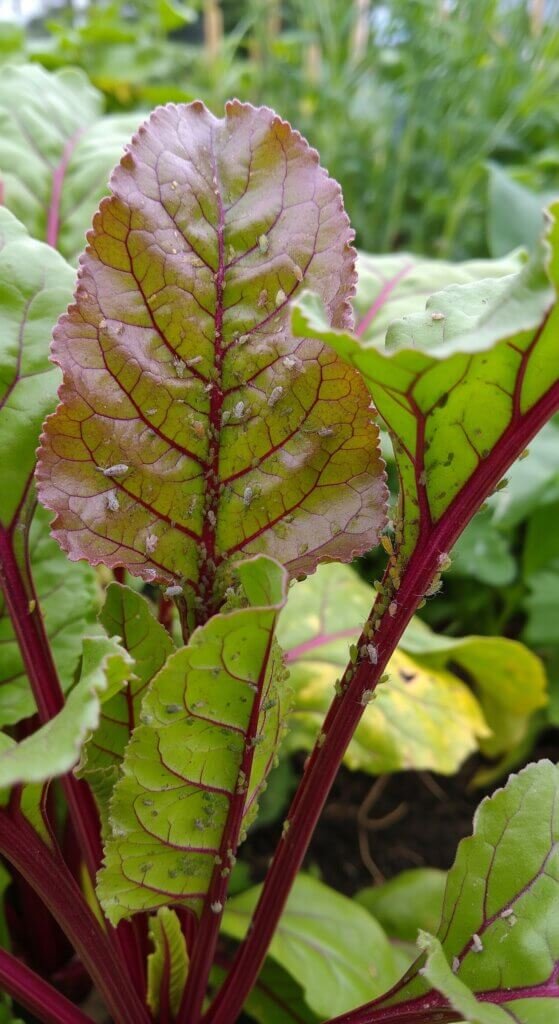
Chemical Control as a Last Resort
Look, we all want to be the cool, chemical-free gardener.
But sometimes, aphids go full zombie horde and you have to bring out the big guns. Just do it responsibly, okay?
Selective Insecticides
If you have to spray, go for selective insecticides—stuff like afidopyropen or cyantraniliprole.
These are modern formulas that target aphids without wiping out your entire beneficial bug crew.
Application guidelines:
- Read the label—yes, actually. It matters.
- Spray on calm days (no wind = less drift).
- Avoid bloom time—you don’t want to take out your bees.
- Spot-treat—don’t go full “spray and pray.”
Systemic insecticides
These get sucked up into the plant and keep working from the inside out.
Great for long-term control—but only if nothing else has worked.
Important considerations:
- They hang out in plant tissues, so time your harvests carefully.
- They can affect pollinators and good bugs, so go slow and be smart.
- Use them like hot sauce: a little goes a long way.
Monitoring and Follow-Up
So you knocked the aphids down—awesome. But don’t ghost your plants just yet.
These little pests are persistent, and you’ve gotta keep an eye out or they’ll make a comeback tour like it’s the ’90s.
Regular checking
Pop into your garden once a week and look for:
- Fresh clusters of aphids setting up shop
- Wilting leaves or weird plant vibes
- Good bugs doing their thing (ladybugs, lacewings = green light)
- Overall plant health—droopy = danger
Integrated approach
Long-term success = not relying on just one trick. The real magic? Layering your strategies:
- Prevent aphids from showing up with smart planting combos and healthy soil habits
- Jump in early with sprays or soapy water when you spot the first few
- Let nature help with ladybugs, lacewings, and wasps
- Use chemicals only if things get wild and other stuff doesn’t cut it
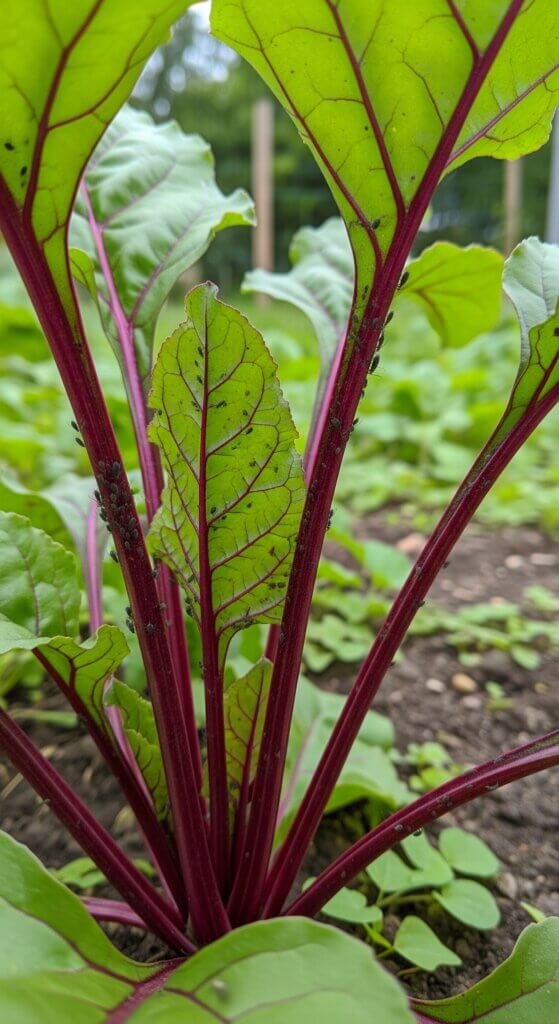
Conclusion
Keeping beetroot aphid-free takes a mix of prevention, early spotting, and organic fixes.
Think less chemical warfare, more working with nature—bring in the ladybugs, keep your garden clean, and act fast when you see those little green suckers show up.
Check your plants regularly, stay patient, and trust the process.
With a little consistency and the right moves, your beets will thrive—and aphids won’t stand a chance.


